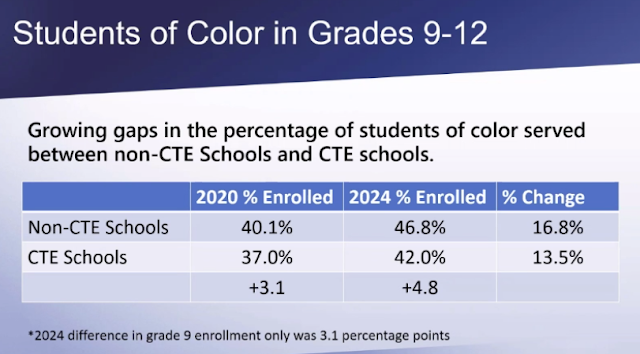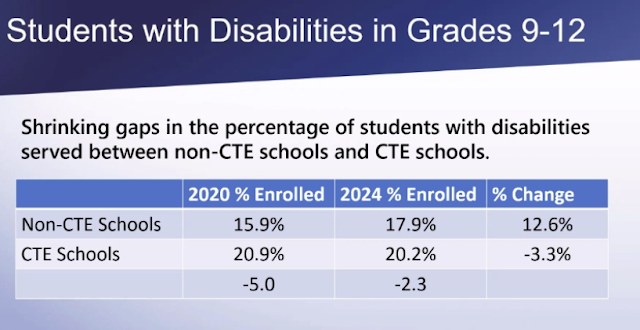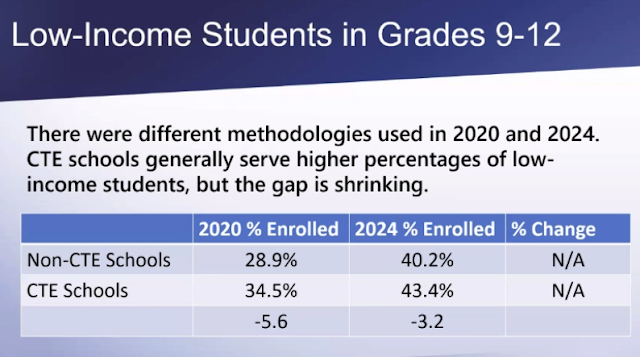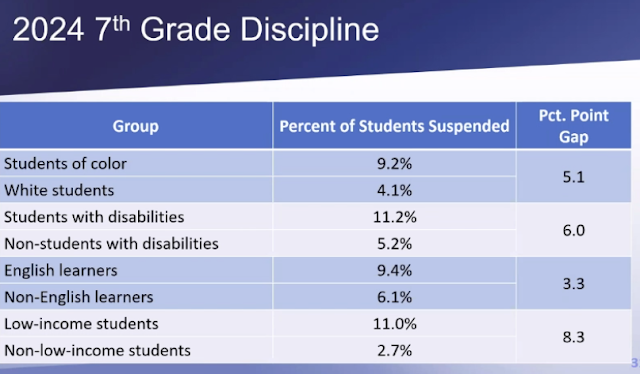The Board of Elementary and Secondary Education met virtually on Monday, October 28 and in person on Tuesday, October 29. The agenda for both meetings can be found here. The video of both sessions can be found here.
Monday was the first of two of what the Department has termed “study sessions” on admission for “wall to wall” career and technical education schools . This specifically is about the 29 regional vocational technical and agricultural schools and the 5 municipal schools; this is not about the programs that run at 58 comprehensive high schools.
After the 2021 change in policy which allowed for such schools to set their own admission requirements, 25 of the 29 regional schools kept selective criteria like grades, attendance, and discipline; many shifted weight within the criteria or adjusted how they score. The use of such measures is allowed under Title VI, so long as the criteria don’t have a disproportionate impact on protected classes, and provided the two part test under the Title is met. Two schools adopted a full or partial lottery, as did one municipal school; two agricultural schools removed grades and recommendations as selective criteria.
Dr. Shaun Dougherty of Boston College reported on his research, first on Connecticut selective admission Career and Technical Education, which found a student who was less likely to graduate is more likely to graduate having been admitted to such a program; and further found an increase in their first quarter of earnings. In 2019, Dougherty ran a simulated lottery of admission to some schools. While tweaking the selective admission criteria sometimes resulted in a result that looked less like the sending districts, the simulated lottery resulted in a student population that looked like the sending district.
In using state data now shared through the CTE-ART: Career Technical Education Analysis and Review Tools, the state found the following disparities between the student bodies of the 34 wall to wall CTE schools and the remaining comprehensive high schools: 
These are “statistically significant” and growing gaps between non-CTE and CTE schools in students of color served.
For English learners, there is likewise a statistically significant and growing gap between non-CTE and CTE schools.

The gap between serving students with all disabilities (which went in the direction) remains but has closed.

It is not possible to do a straight comparison between 2020 and 2024 in low income, as the methodology has changed, but it is fair to say that the gap (again in the reverse direction) remains but is closing.
Comparing the entire non-full-time CTE student body to those in CTE schools was, those from the Department noted, important as the state has the responsibility of serving all students. The Board was reminded “we want these schools to look like our student population” and “our demographics have changed statewide.” This faced pushback from several Board members, most notably Vice Chair Hills who repeatedly argued for a comparison against only the member districts of the CTE schools. Students can apply from outside of the districts of the schools, however.
The Department also ran the impact on protected classes if certain criteria are used in admissions. As the Department does not have the half year data actually used, they used 7th grade as a proxy, and found the following:

Thus the use of attendance is likely to disproportionately impact these groups.

Thus the use of discipline data is likely to disproportionately impact these groups.
The Department then reviewed challenges and potential challenges of awareness, recruitment, admission, and retention.
Among solutions for awareness proposed were revising regulation and guidance to address community concerns. For admission, creating a more consistent, statewide approach, possibly a more proactive statewide approach and eliminate the use of selective criteria.
Member Moriarty asked about possible expansion of programs. Hills wanted an evaluation of how cooperative sending districts are.
Chair Craven said we have to decide the problem we’re trying to solve before we engage in solutions.
______________________________________________________________________________________________________
Public comment
Tuesday’s meeting opened with public comment (writer’s note: the video failed to have sound for several minutes at the beginning of the meeting as well as at one part in the middle of the meeting; those parts then are noted as not covered.)
The superintendents of Greater New Bedford Tech, Keefe Tech, and Old Colony Regional spoke, questioning the Department’s methodology, raising concerns from their own regional agreements, and commenting that discipline and attendance data are necessary for their admission requirements. Representatives from both Lawyers for Civil Rights and the Center for Law and Education spoke, urging the Department to implement a true lottery system, as urged by the complaint filed by those organizations with others, and noting that, as the criteria for admission are only used when there is more interest than seats, it is not necessary for the operation of the programs.
There was a comment which both opposed question 2 on the MCAS and critiqued the current system. There was a comment regarding the Racial Imbalance Advisory Committee report, which was among the reports sent to the Board for information but were not discussed.
A Boston parent whose children attend the Cohasset Public Schools spoke of their experience there of a pattern of hate and of teachers who did nothing. She asked “why should it be the responsibility of those who continue to be marginalized to lead the work”? She requested DESE oversight in suburban districts like Cohasset “and others we’ve seen on the news recently.”
Chair Craven announced the updated membership of Board committees. Among the items discussed at the October 17 budget committee were attendance, literacy launch, diversification of teachers, ch. 74, and “local inflationary pressures.”
Secretary Tutwiler said, “we are in full swing in the school year” and he remain deeply inspired and encouraged by what he sees across the Commonwealth.
He briefly spoke of STEM week and then reiterated the administration’s position on question 2: both the administration and he personally are “adamantly opposed to this question…[it is] part of the success story in public education.” The ballot question “does not replace the system with a system…[it is] the most vulnerable students will be hurt the most..” He said, “the current system is not a perfect system, and I would be the first to say that” and he is open to an evolving system, “but this is not the way.”
Acting Commissioner Johnston likewise spoke of STEM week. He announced that he will be bringing to the Board next month a recommendation to raise the tuition of the two Massachusetts virtual schools, on which the Board will then vote in December. He also noted recently shared resources on antisemitism and societal bias.
On CTE admissions
Johnston then briefly reviewed what had been presented the evening before, and the chair opened it to questions from members.
Member Moriarty said that there are human beings behind the data, and recommended a voluntary state class in “good school citizenship” for those who would otherwise be ruled out of admission to a CTE school to allow them access.
Vice Chair Hills said that his first question was if the criteria are legal; if so, he wants to know what the aim of admission is. As it is a scarce resource, people left out will feel aggrieved. He also asked again about disparities between sending districts and CTE schools.
Member West said that they have to think at the individual school level and that representativeness is not the legal standard.
Member Fisher said, “I want to remind the Board that we’re talking about individuals…these [students left out by the criteria outlined] are the students that may need the CTE schools the most to recenter and reengage them,” adding “our comprehensive schools don’t get to skim.”
Hills then spoke again to wonder how big a problem discipline is.
Member Rocha wondered about language support at CTE schools, and about attendance at the schools between shop week and academic week.
Craven said, “our job is to separate the signal from the noise.”
Johnston said that they had been considering a panel, but this now looked as if the Board was asking for an additional presentation on data, to which Craven responded that both, including schools discussing why they hadn’t moved to a lottery.
Commissioner’s search
Craven announced that she has appointed herself, Tutwiler, Fisher, and West to the search committee. Isaacson, Miller is scheduling individual interviews with members.
There is also now a public survey in several languages to inform the search.
Underperforming and chronically underperforming schools and districts
The Board then turned to an update on underperforming and chronically underperforming schools and districts.
Three schools were announced as exiting such status:
- Oliver Middle School, Lawrence
- Van Sickle Academy, Springfield
- High School of Commerce, Springfield
While the Acting Commissioner did not name any new underperforming or chronically underperforming schools or districts, he did name five “schools of concern” which are:
- Brockton: Arnone Community Elementary School
- Chelsea: Clark Avenue Elementary School
- Framingham: Harmony Grove Elementary School
- Springfield: Lincoln Elementary School
- Worcester: North High School
“if schools do not improve rapidly, they’re up for consideration as underperforming in future years.”
Member Fisher asked about financial support for these schools; the grant is the same size for all, regardless of the size of the school.
Moriarty said we’re “in a troubling place right now” with results coming from schools; he added, “to meet our constitutional obligation, there needs to be a serious rethinking of what’s effective.”
Johnston said it would be discussed in January.
John Avery Parker School of New Bedford is exiting chronic underperformance and state receivership, which it has been in since 2013. Johnston said they “really have great confidence in the district” to bring “the school back into the fold of all of the elementary schools.” The district is exploring making it an early childhood center.
Finally, it was announced that Holyoke, which has been in state receivership since 2015, will exit, it is anticipated, on July 1, 2025.
Mayor Joshua Garcia and Superintendent Receiver Anthony Soto, both of whom grew up in Holyoke, were there to respond to the news. Garcia, who introduced himself first in Spanish, noted that the school committee had met each month during receivership. He said he was appreciative of the work that had been accomplished. Soto, “a very proud Puerto Rican from Holyoke,” outlined some of that work around the increase in graduation rates, dual language, early college, and preK.
Garcia observed to the Board that the social determinates of health, housing, and other items which surround the children of Holyoke should be worked on in partnership between the state and the cities, rather than having teachers try to solve them in the classrooms.
Educational vision and DESE work
Finally, the Board was updated on work the Department is directly doing.
The Board was introduced to what Department is calling a “curriculum dashboard” which can be found here. It reports what the Department has gathered from districts on what it terms “high quality instructional materials,” so determined by the state’s CURATE process. Having seen this, Moriarty suggested that perhaps this could now be tied to learning outcomes, and anticipated it impacted the educational publishing industry. Johnston said that the next step would be moving this to a requirement for districts.
There was also an update on review process on teaching review through Literacy Launch; the goal was by this year all early childhood, elementary, and moderate disability teacher candidates would be prepared.
The Board was introduced to the registered teacher apprenticeship program (R-TAP), which will provide for educators to earn licensure while working in a full time instructional role under another educator. This work has been years in the making, and the hope is that this would support diversification of the field as well as help to address shortages like those in central and western Mass. It is funded by DESE grant; federal grant; EOLWD grant; scholarship; WIOA workforce. It will commonly cover: tuition and fees, wraparound supports, licensure fees; childcare and transportation
possibility of pre-apprenticeships; community college pathways; possible principal apprenticeship.
Johnston finally turned to what he said was a response to the Board’s call for addressing pandemic learning loss, which he is framing as “advancing student learning.” He outlined the following as proposed for next year, including for budgets:
- 600 teacher leaders in buildings to improve adult practices through imbedded professional development
- one year of high dosage tutoring of up to 13,000 students in grade 1 resulting in decrease of students below benchmark in early literacy
provide one year of high dosage tutoring for up to 10,000 students in grade 4-5 in math resulting in decrease of students not meeting expectations in 2026 MCAS
provide one week “additional intensive instruction” to up to 20,000 students in grades 3-12 resulting in an increase of percentage of students meeting or exceeding expectations in MCAS - “facilitate” up to 100 new adoptions of “high quality instructional materials”
- grants of up to 150-200 districts for MyCAP planning and FAFSA completion
grants around dropout prevention in up to 50 districts
“opportunities” for up to 4000 additional students in CTE, early college, and/or innovation career pathways
The Board members who spoke largely favored the proposals.
The Board will next meet on the evening of November 18 for the second study session on CTE admission. They will meet in person the next morning, November 19, in Holyoke.
